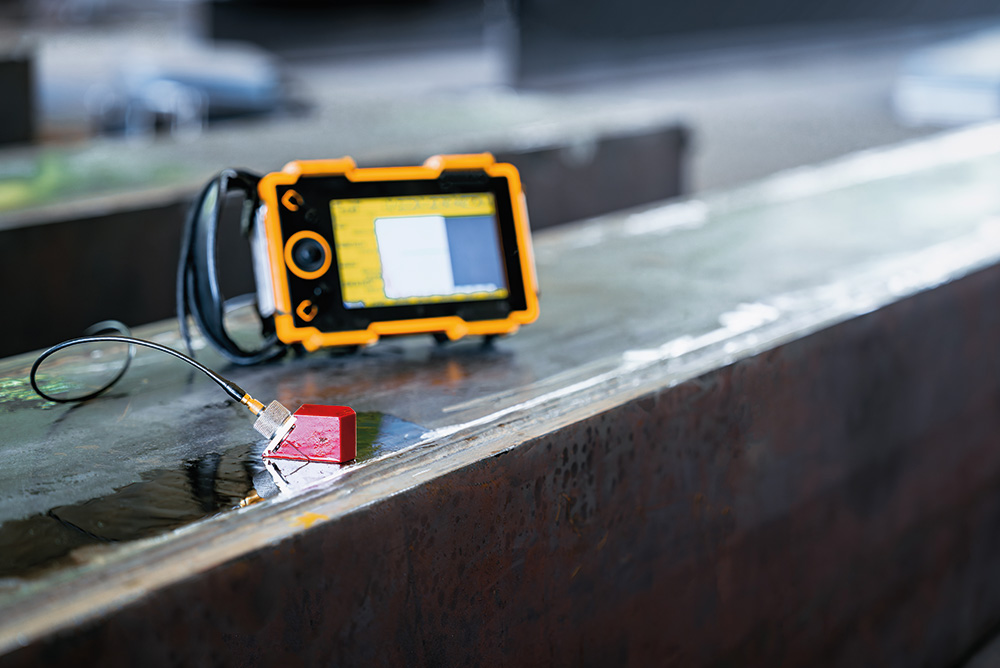
The ultrasonic testing is an acoustic method for detecting material defects. This is a non-destructive testing method. Thus it is possible to test components when installed e.g. components of an aircraft.
Like all the other testing methods the ultrasonic testing is standardised and is implemented according to the guidelines. For this process a coupling aid (e.g. glue, gel, water or oil) is applied on the surface of the tested object. By means of a probe, which emits and receives ultrasonic waves between 0.2 MHz and 50 MHz the tested object is scanned. This can be done manually, mechanised or automatically (on the production lines). At the latter, the tested object is dipped in a suitable liquid (dipping technique) or moistened for better transmission of the sound signal.
Changes of the acoustic characteristics at edge surfaces (e.g. a cavity, an inclusion, a fissure or another separation of the material) inside the tested object reflect the ultrasonic impulse and send it back to the probe, which works as an emitter and as a receptor. he passed time between sending and receiving the signal makes it possible to calculate the distance (pulse-echo method). With the calculated time a signal pattern can be provided and visualised on a screen. The picture indicates the position, while the size of the discontinuity can be determined by comparing it with a second reflector (flat bottom hole, reflector, flute, cross-hole).
Ultrasonic wall thickness measuring systems indicate the wall thickness after calibration as a decimal number.
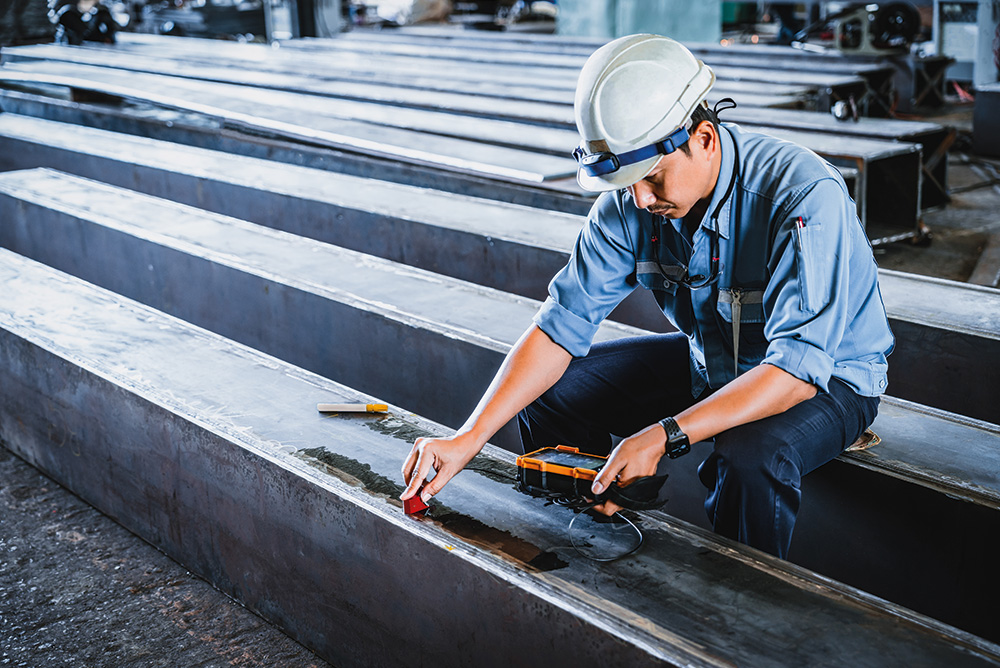
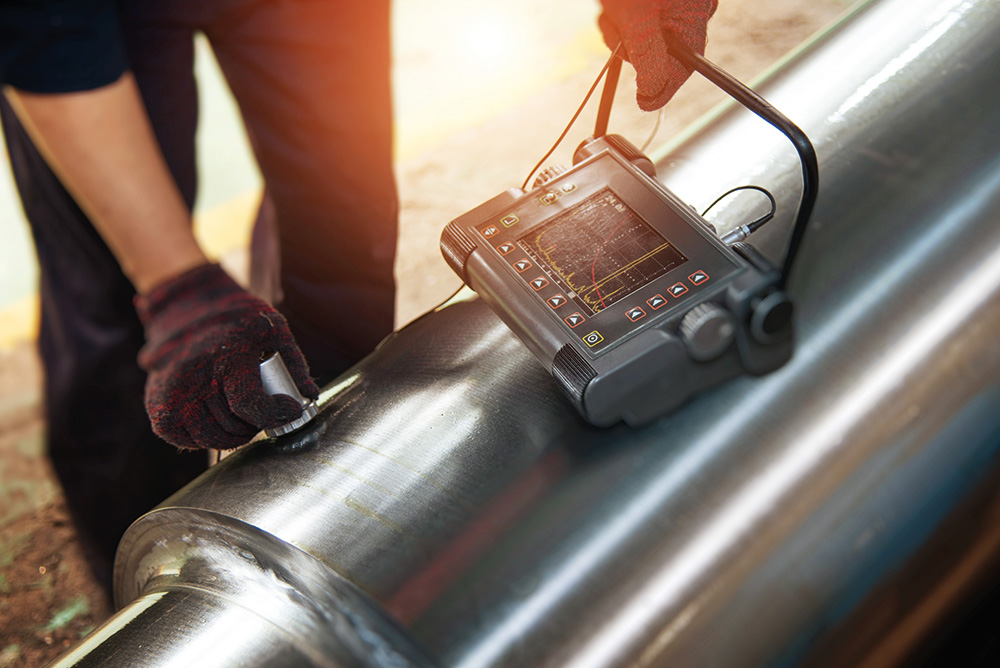
The ultrasonic testing method is an appropriate tool for sound-conducting materials (most metals belong to this group) for detecting internal and external flaws e.g. at welds, forged pieces, cast iron, wrought material and pipes. Railway tracks are tested routinely with special testing trains. The detection of external (surface-) flaws is especially important for parts, where the inside of the material cannot be tested.
There are two general procedures which can be utilized:
The tiniest discontinuity that can be detected is bigger than half of the wave-length of sound, which depends on the sound velocity of the tested material and the frequency of the probe. At a frequency of 4 MHz the discontinuity in steel amounts to 0.7mm. The height of the frequency cannot be increased limitlessly, since the particle size of the structure leads to diffusion and absorption and therefore the depth of penetration is reduced. The rougher the crystallisation in e.g. cast steel is, the longer the waves of the chosen sonic frequency. For cast iron or austenite, the testing methods are usually very limited. The longest distances that can be scanned with the impulse-echo method are up to 5 meters, which equals a sound path of 10 meters. The smallest resolution would be the wall thickness measurement of a razor blade with a 50 MHz probe.
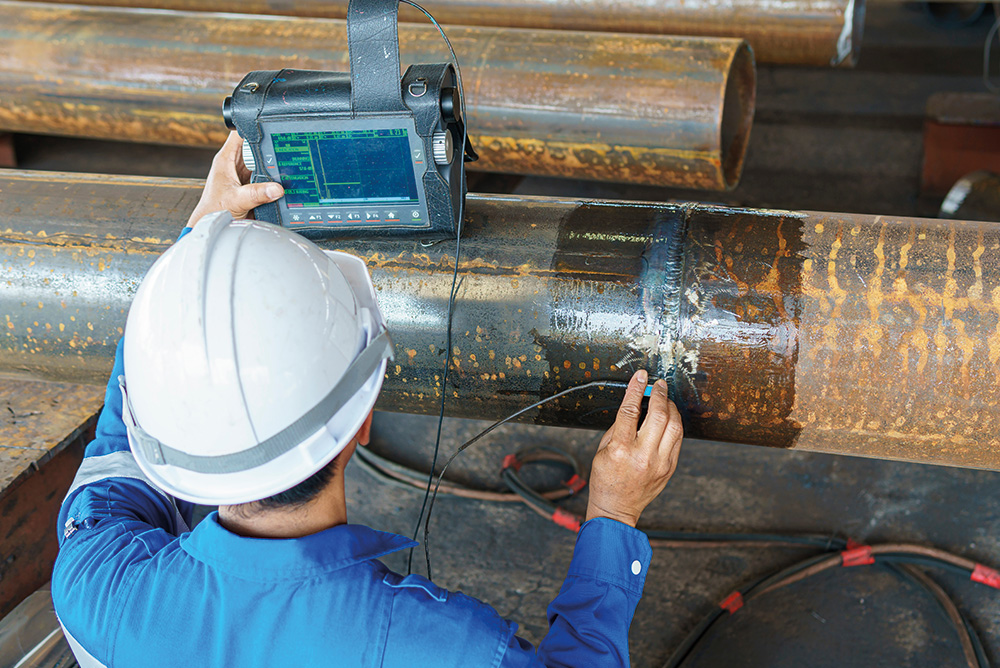
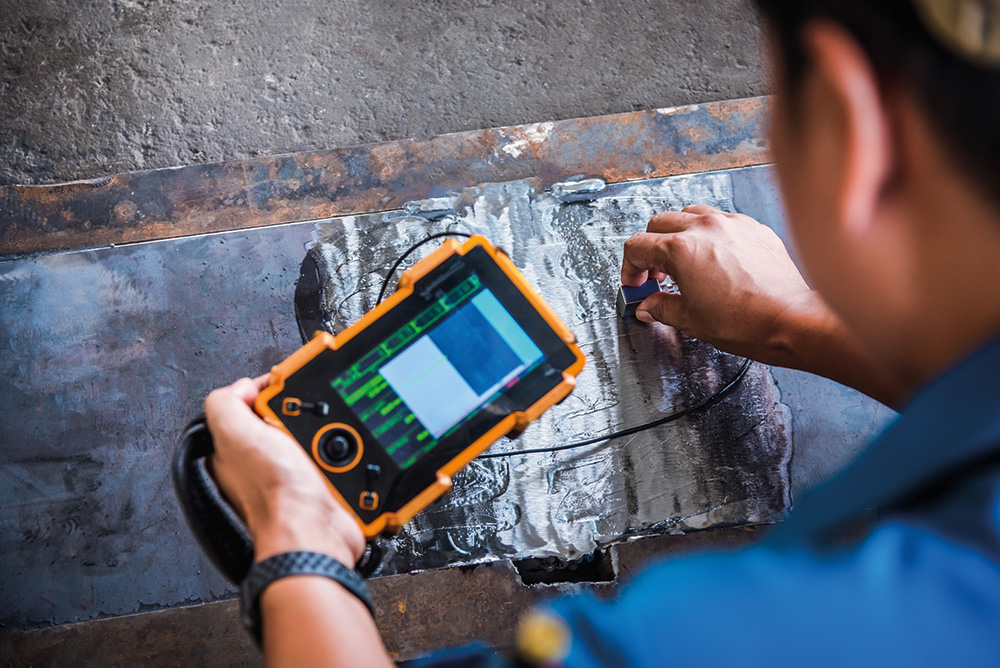
This process includes two probes, which are attached to one ultrasonic device. One probe sends the impulse while the other receives the impulse on the exact opposite side of the tested part. This method is very specific and is usually needed for the detection of flaws. The squirter-technique is an example for the combination of the dipping technique and through-transmission method. In this case the two probes are not attached to the tested object, but are attached aside each other in a distance of several centimetres and are connected through water. This technique is used e.g. at Airbus for large-area testing of CFK/GFK tail unit components.
There are approximately forty different special testing methods and new methods are added every year. A special testing method is understood as the usage of acoustic effects in materials aside from the “classic” detection methods.
Important methods are e.g. Phased Array, TOFD etc. Sometimes they only differ in the way of signal processing.
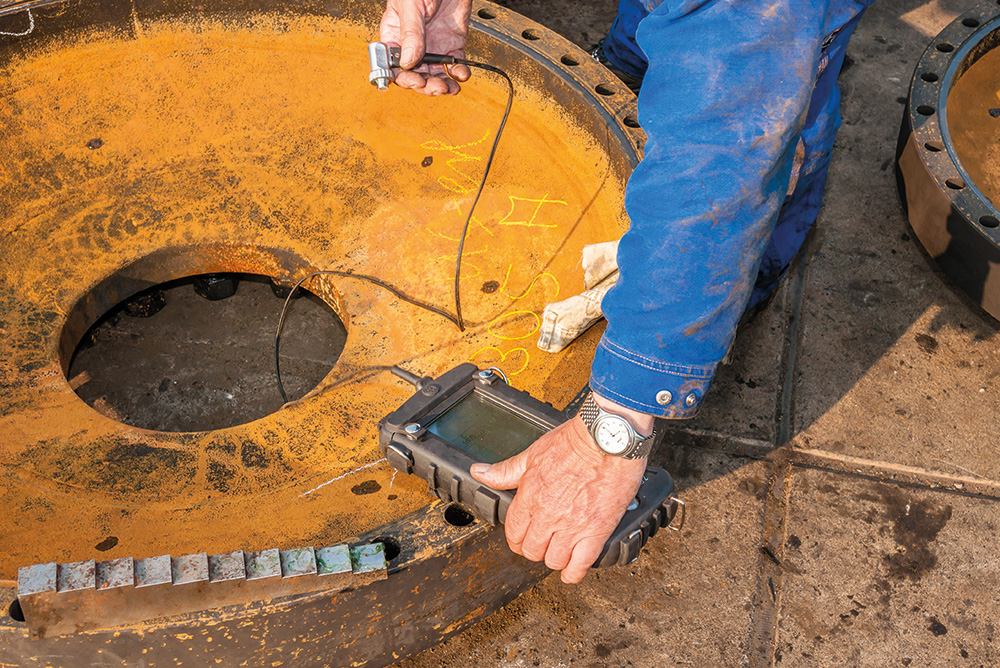
Get an insight into our work.
ÖN EN 583, Zerstörungsfreie Prüfung – Ultraschallprüfung
ÖN EN 1330-4, Zerstörungsfreie Prüfung – Terminologie – Teil 4: Begriffe der Ultraschallprüfung
ÖN EN 1712, Zerstörungsfreie Prüfung von Schweißverbindungen -Ultraschallprüfung von Schweißverbindungen – Zulässigkeitsgrenzen
ÖN EN 1713, Zerstörungsfreie Prüfung von Schweißverbindungen -Ultraschallprüfung – Charakterisierung von Anzeigen in Schweißnähten
ÖN EN 1714, Zerstörungsfreie Prüfung von Schweißverbindungen -Ultraschallprüfung von Schweißverbindungen
ÖN EN 10160, Ultraschallprüfung von Flacherzeugnissen aus Stahl mit einer Dicke größer oder gleich 6 mm (Reflexionsverfahren)
ÖN EN 10228-3, Zerstörungsfreie Prüfung von Schmiedestücken aus Stahl – Teil 3: Ultraschallprüfung von Schmiedestücken aus ferritischem oder martensitischem Stahl
ÖN EN 10228-4, Zerstörungsfreie Prüfung von Schmiedestücken aus Stahl – Teil 4:Ultraschallprüfung von Schmiedestücken aus austenitischem und austenitisch-ferritischem nichtrostendem Stahl
ÖN EN 12223, Zerstörungsfreie Prüfung – Ultraschallprüfung – Beschreibung des Kalibrierkörpers Nr 1
ÖN EN 12668, Zerstörungsfreie Prüfung – Charakterisierung und Verifizierung der Ultraschall-Prüfausrüstung
ÖN EN 12680, Gießereiwesen – Ultraschallprüfung
ÖN EN 14127, Zerstörungsfreie Prüfung – Dickenmessung mit Ultraschall
ÖN EN 15617, Zerstörungsfreie Prüfung von Schweißverbindungen – Beugungslaufzeittechnik (TOFD) – Zulässigkeitsgrenzen
ÖN EN ISO 7963, Zerstörungsfreie Prüfung – Ultraschallprüfung – Beschreibung des Kalibrierkörpers Nr. 2
ÖNN EN ISO 10863, Schweißverbindungen – Anwendung der Beugungslaufzeittechnik (TOFD) für die Prüfung von Schweißverbindungen
SEP 1923, Ausgabe: 12/1990, Ultraschallprüfung von Schmiedestücken mit höheren Anforderungen, insbesondere für Bauteile in Turbinen- und Generatorenanlagen
ÖNORM M 3002, Ausgabe: 1. Juli 2004, Ultraschallprüfung von Umformprodukten (geschmiedet, gewalzt) mit höheren Anforderungen aus Stahl und anderen metallischen Legierungen – Durchführung, Prüfumfang, Güteklassen
CCH 70-3 UT 70-3, Pflichtenheft für die Abnahme von Stahlgußstücken für hydraulische Maschinen
AD-Merkblatt HP 5/3
AD-Merkblatt HP 5/3 Anlage 1
AD2000-Merkblatt HP 5/3
AD2000-Merkblatt HP 5/3 Anlage 1
We work dedicatedly and with full commitment for our customers. We enjoy our work. You can see this in the way we treat each other and in the quality of our work.